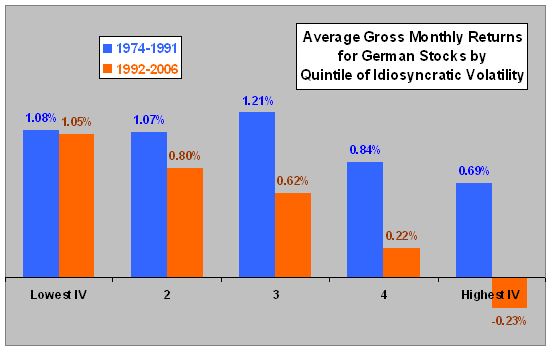Conventional theory holds that financial markets reward risk (volatility) with return. Do stocks with relatively high volatilities in fact generate relatively high returns? In his April 2010 paper entitled “Low Risk and High Returns: Evidence from the German Stock Market”, Stefan Koch examines the relationship between past idiosyncratic volatility and future returns for individual German stocks. Using daily stock return and firm characteristics data for a broad sample of German firms spanning 1974-2006, he concludes that:
- The average gross return of an equally weighted portfolio that is long (short) the fifth of stocks with the lowest (highest) idiosyncratic volatilities, reformed monthly, is 0.79% per month or about 9% per year. Results are similar for sorting on total rather than idiosyncratic volatility. In other words, low-volatility stocks tend to outperform high-volatility stocks.
- Stocks with low idiosyncratic risk tend to be those of large firms with low book-to-market ratios.
- The volatility risk premium is larger in magnitude and more systematic during 1992-2006 than during 1974-1991 (see the chart below).
- Controlling for market, size, book-to-market and momentum factors, the average idiosyncratic risk hedge portfolio return exceeds 10% per year.
- The volatility risk premium is robust to equal versus value portfolio weights, stock liquidity, upside and downside versus total idiosyncratic volatility, the short-term reversal effect, different measures of idiosyncratic risk and monthly versus daily data.
The following chart, constructed from data in the paper, summarizes average monthly gross returns for German stocks by quintile of idiosyncratic volatility, reformed monthly, over two subperiods. The negative idiosyncratic volatility risk premium is more pronounced in the later than the earlier subperiod (-1.28% versus -0.39% per month), perhaps because recent volatility is generally higher. Also, average sample size is higher during 1992-2006 (446 stocks) than during 1974-1991 (207 stocks), suppressing effects of outliers. Results are similar for total volatility.
Note that returns do not include trading frictions incurred for monthly portfolio adjustments.

In summary, evidence indicates that investors may be able to exploit a significantly negative idiosyncratic risk premium among German stocks, robust to a broad set of portfolio specifications and controls.